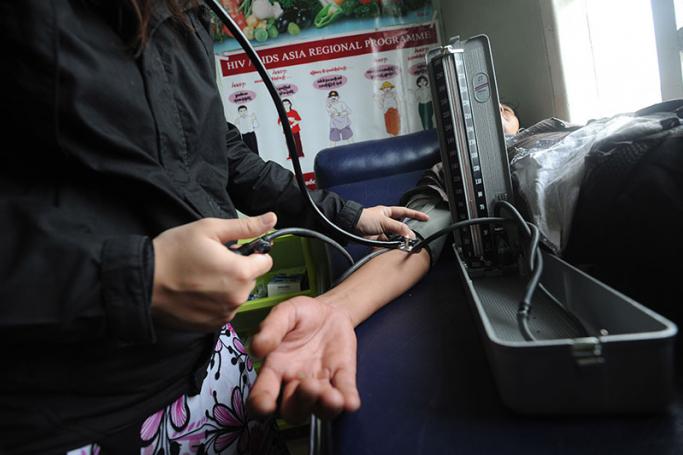A UNAIDS report on the global HIV epidemic finds AIDS-related deaths in Myanmar have dropped by 52% in the past 6 years which is the steepest decline in Asia and the Pacific, the organisation said. Since 2010, annual new HIV infections have also fallen by 26%. This is double the regional average of 13%. The new report Ending AIDS: Progress towards the 90-90-90 targets was launched at an event in Paris, France on 20 July.
“The phenomenal drop in AIDS-related deaths and new HIV infections are strong indicators of the progress of Myanmar’s national HIV response,” said Oussama Tawil, UNAIDS Country Director. “This shows the country’s leadership, commitment and engagement is having results, which are saving thousands of lives.”
The large decline in AIDS-related deaths is due to a massive scale-up in HIV treatment over the past few years. In 2013, the Myanmar government started to decentralize HIV services to provide HIV prevention and treatment even in remote rural areas, through government-run clinics. Previously HIV treatment was mostly available only in private clinics.There were an estimated 230,000 people living with HIV (PLHIV) in Myanmar as of 2016 and 57% were accessing life-saving antiretroviral therapy. This is a four-fold increase since 2010. Significant efforts have also been made to eliminate new infections among children with 88% of women living with HIV accessing services for the prevention of mother to child transmission.
Myanmar’s HIV epidemic is concentrated among key populations of people who inject drugs (PWID), men who have sex with men (MSM) and female sex workers (FSW) with national HIV prevalence at 28.5%, 11.6% and 14.6% respectively, based on data from the National Strategic Plan on HIV and AIDS 2016-2020.
Available data also indicates that some big cities share a larger burden of the epidemic with high HIV prevalence among key populations. In Waingmaw, Kachin State, HIV prevalence among PWID reached as high as 47%. In Yangon City, HIV prevalence among MSM is at 26.6%, FSW at 24.6% and PWID at 29%.
The new report highlights Myanmar’s efforts in providing key harm reduction services to people who inject drugs to prevent the spread of HIV and reduce other harms associated with drug use. Between 2014 and 2016, the government distributed more than 300 sterile needles and syringes per person who injected drugs.
“While we are now seeing positive results in the reduction of deaths and new infections, Myanmar’s momentum must be sustained to achieve its goal of ending the AIDS epidemic as a public health threat by 2030. Continued commitment and support from the government, donors, international and national non-government organizations, community networks and PLHIV groups is crucial in achieving the country’s HIV response targets,” added Mr. Tawil.
The Ministry of Health and Sports has recently launched Myanmar’s third National Strategic Plan on HIV and AIDS 2016 to 2020, a five-year road map to Fast-Track the country’s national HIV response. The plan aims for the achievement of the global 90–90–90 targets—whereby 90% of people living with HIV know their status, 90% of people who know their HIV-positive status access treatment and 90% of people on treatment have suppressed viral loads. The plan also aims to ensure that 90% of key populations have access to HIV prevention services and 90% of people living with and affected by HIV report zero discrimination, especially in health, education and workplace settings.
You are viewing the old site.
Please update your bookmark to https://eng.mizzima.com.
Mizzima Weekly Magazine Issue...
14 December 2023
New UK Burma sanctions welcome...
13 December 2023
Spring Revolution Daily News f...
13 December 2023
Spring Revolution Daily News f...
12 December 2023
Spring Revolution Daily News f...
11 December 2023
Spring Revolution Daily News f...
08 December 2023
Spring Revolution Daily News f...
07 December 2023
Diaspora journalists increasin...
07 December 2023
Euromoney Myanmar Global Investment Forum begins in Nay Pyi Taw












